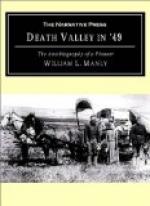We had not taken pains to keep track of the day of the week or month; the rising and setting of the sun and the changes of the moon were all the almanacs we had. Then snow came about a foot deep, and some days were so cold we could not leave our camp fire at all. As no Indians appeared we were quite successful and kept our bundle of furs in a hollow standing tree some distance from camp, and when we went that way we never stopped or left any sign that we had a deposit there.
Some time after it was all frozen up solid, some men with two yoke of oxen came up to cut and put logs in the river to raft down when the ice went out. With them came a shingle weaver, with a pony and a small sled, and some Indians also. We now had to take up all of our steel traps, and rob all our dead-falls and quit business generally—even then they got some of our traps before we could get them gathered in. We were now comparatively idle.
Until these loggers came we did not know exactly where we were situated, but they told us we were on the Lemonai river, a branch of the Wisconsin, and that we could get out by going west till we found the Mississippi river and then home. We hired the shengle man with his pony to take us to Black River, farther north which we reached in three days, and found a saw mill there in charge of a keeper. Up the river farther we found another mill looked after by Sam Ferguson. Both mills were frozen up. The Indians had been here all winter. They come from Lake Superior when the swamps froze up there, to hunt deer, till the weather gets warm, then they returned to the Lake to fish.
Of course the presence of the Indians made game scarce, but the mill men told us if we would go up farther into the marten country they thought we would do well. We therefore made us a hand sled, put some provisions and traps on board, and started up the river on the ice. As we went the snow grew deeper and we had to cut hemlock boughs for a bed on top of the snow. It took about a half a cord of wood to last us all night, and it was a trouble to cut holes in the ice to water, for it was more than two feet thick. Our fire kindled on the snow, would be two or three feet below on the ground, by morning. This country was heavily timbered with cedar, or spruce and apparently very level.




